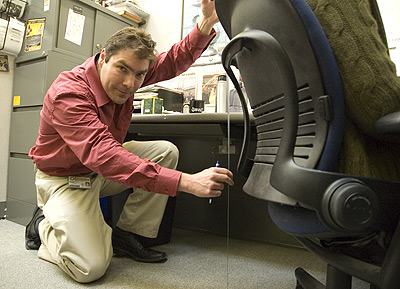Berkeleyan
 |
Greg Ryan, above, takes measure of Berkeley staff and faculty, the better to help them find healthy ways to work. (Deborah Stalford photo) |
It's My Job
![]()
27 February 2008
 |
In this semi-regular feature, the Berkeleyan showcases a staff member whose work is essential to the smooth functioning of the campus (or one of its many departments and units). Do you know someone whose job would interest our readers? Send an e-mail to berkeleyan@berkeley.edu with your suggestions.
Greg Ryan
Ergonomics Specialist, University Health Services
What does your job involve?
I manage ergonomic programs that look at new ways to reduce body stresses to cut down on work-related injuries. My work focuses primarily on three things: finding equipment that best fits the user, determining the most efficient workflow, and avoiding repetitive movements.
Does that usually address the problem?
Even if you set up a workstation perfectly, people can still get into unsafe postures, because the computer draws you into a hunched-over position. It's helpful simply to be aware of your posture.
What's the most common injury on campus?
Repetitive-strain injuries are the most common type we address. That's because we have 17,000 staff and faculty computer users. Sitting for long periods of time puts a lot of pressure on your back and upper body. The good news is these injuries have been reduced by one-third in the last three years with the help of department evaluators.
When you're assessing someone, what's the first thing you look for?
I generally start by focusing on how their body is positioned. I look at their chair and sitting posture. Do they have adequate lower-back and upper-back support? Are their feet firmly on the ground? I look at the position of the keyboard, mouse, and monitor. Also, I talk to the worker - are they doing a lot of paperwork? Swiveling around in their chairs a lot? Everyone's a little bit different, and that's the tough thing about ergonomics - it's really a gray science. It's not black and white. Everyone's body and work style are a little different.
What might people not realize about your job?
When people think of ergonomics, they think of computer ergonomics. But a lot of my work is with employees who have physically demanding jobs, such as custodians, grounds crews, and trades staff. For example, with a custodian, we'll work on using a lighter-weight mop, not bending over in unsafe positions, and mixing up work duties to avoid repeating the same task for long periods of time.
What do you like best about your job?
It's very holistic - at least, that's the approach I take. I have training in kinesiology, biomechanics, and holistic health, and can use what I know about posture, stretching exercises, physiology, and mechanical stresses to try to reduce stresses on the worker. Also, the variety of my job keeps me engaged: In a single day, I might give a lecture, do research, and then demonstrate floor exercises.

